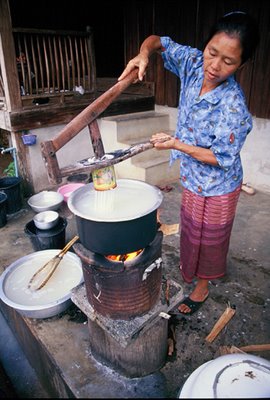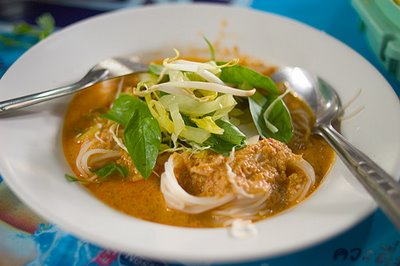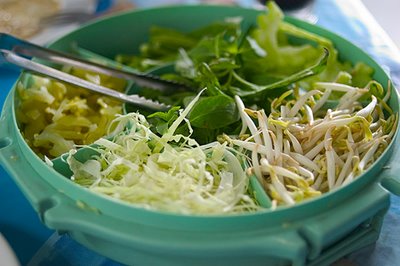Today was definately a theme day: khanom jeen. These are noodles made from fermented rice involving a very unique process. I was able to see this firsthand a couple of years ago in Sangkhlaburi, a small town on the Thai-Burmese border. The name khanom jeen includes the Thai word for Chinese, jeen, which causes many people to think the noodles come from China. However khanom jeen are actually Mon in origin, and as Sangkhlaburi is home to many Mon people, this was an excellent place to see the noodles being made.
The first step involves mixing rice with water. When this mixture is sufficiently soft and slightly fermented, it is boiled, blended and poured through a seive into boiling water:
The mixture solidifies in the water resulting in thin, white noodles, which are immediately stacked:
and sold or consumed, as they tend to spoil quickly.
Back to the present--I'm making an effort to try new places, and the restaurant we visited today, despite being very close to my house, is the kind of place one passes by but never stops at. Well, today we stopped, and it was well worth it.
The first dish I ordered was khanom jeen kaeng khiaow waan look chin plaa kraay (whew!), fermented rice noodles topped with green curry and fish balls made from plaa kraay, a type of freshwater fish:
I assume most of you are already familiar with green curry, but this a particular variant that is typically taken with khanom jeen. The green curry is given some life with slivers of kra chaay, an indegenous root herb somewhat similar to ginger. An authentic recipe for this exact curry can be found here at Chez Pim.
The curry was excellent--one of the best green curries I've had in ages--not nearly as watery as most of the "green curry" peddled around Bangkok nowadays. I wasn't so hot about the fish balls (too rubbery), although Khuat liked them:
(Please note that one does not usually employ chopsticks when eating khanom jeen---she had ordered noodles, saw how delicious my dish looked, and changed her order!)
Being thoroughly impressed with the food at this shop, I ventured further into the world of khanom jeen and ordered a dish of naam yaa:
This is a coconut milk-based curry, this time featuring pureed fish, that is only eaten with khanom jeen. This dish was just as good as the first one--especially considering that it is usually to sweet for me. It also included a generous amount of kra chaay, which gives the dish a simultaneous cooling/spicy flavour!
Upon ordering this dish, I was given a dish of raw veggies to eat with the noodles:
Starting from the bottom and moving clockwise we have shredded cabbage, pickled mustard greens, green beans, parboiled bitter gourd, bean sprouts, and in the center, bai menglak, an herb that has the unfortunate English name, hairy basil. You simply take what you like and mix it up with the noodles and curry.
And as if this wasn't enough khanom jeen, I had another plate at home when I took a pic of khanom jeen naam yaa pak tai, khanom jeen with a spicy southern Thai-style curry for my cookbook on southern Thai food:
I made this one myself, and it is topped with some exotic fresh herbs I picked up at the southern Thai place down the street. This particular curry is, like naam yaa, only eaten with khanom jeen, however it is much, much more spicy, requiring something like 50 dried chilies its chili paste!


















